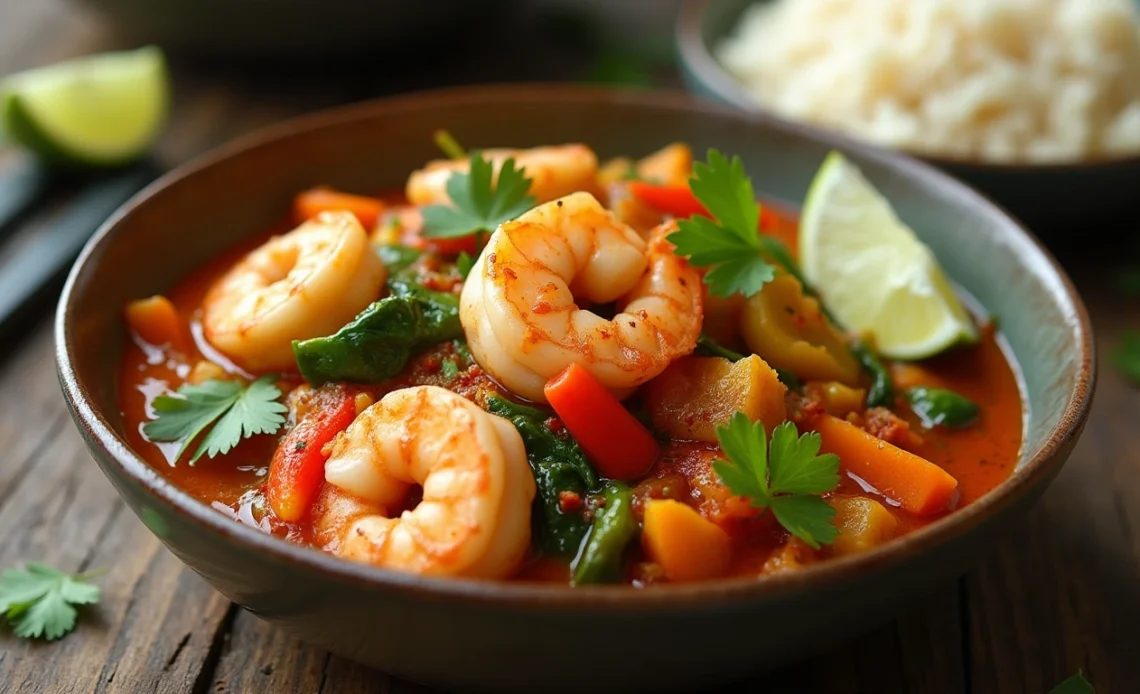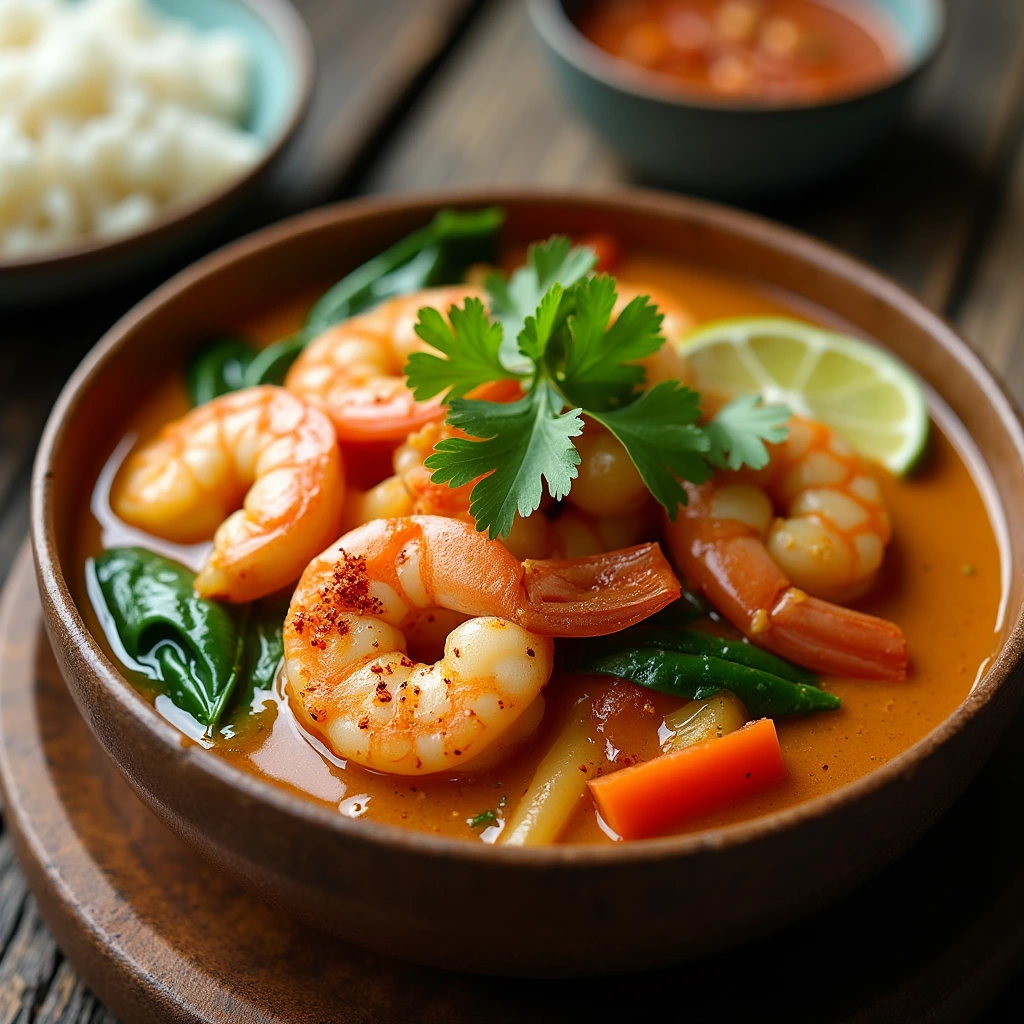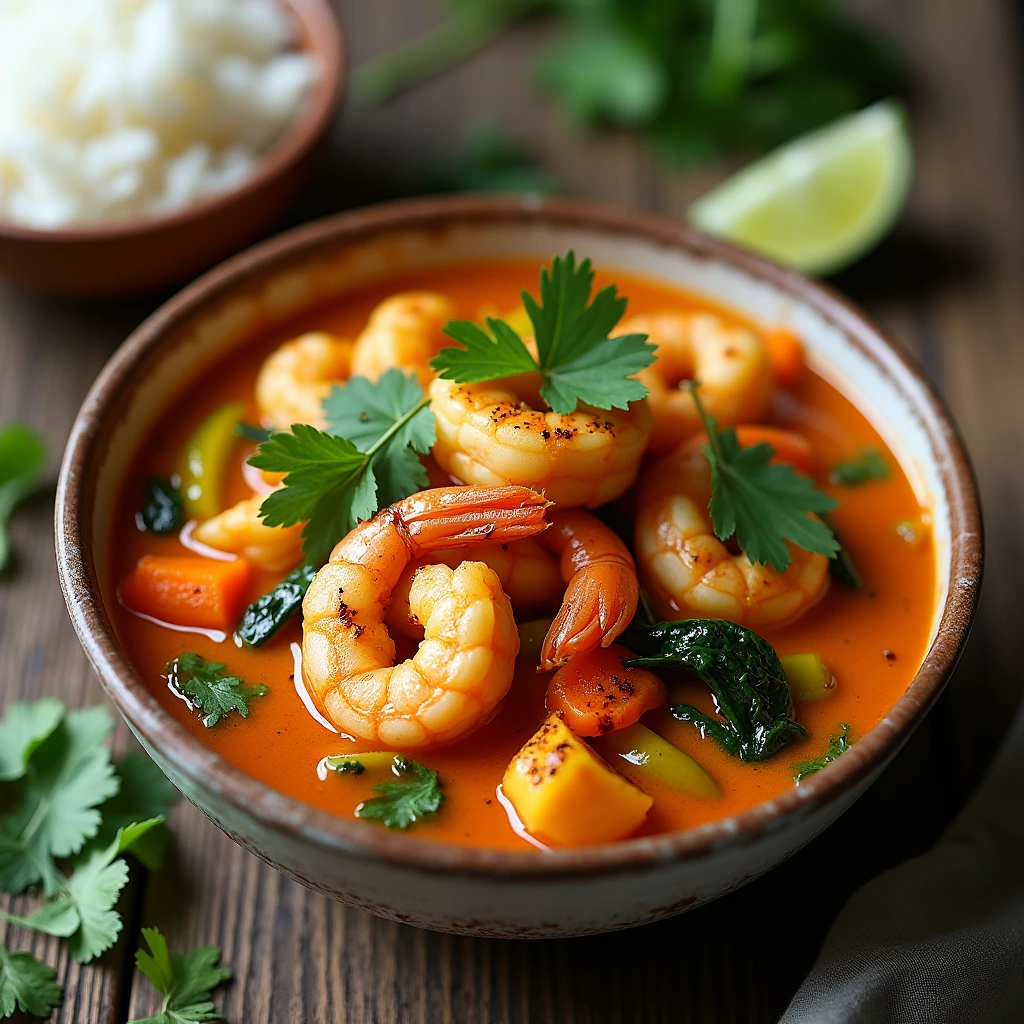
If you’re a fan of seafood and enjoy rich, aromatic curries, then Thai Coconut Shrimp Curry is the perfect dish to tantalize your taste buds. This vibrant and flavorful dish combines the sweetness of coconut milk with the spices of Thai cuisine and the natural succulence of shrimp. It’s an easy yet impressive dish to prepare, making it an ideal choice for a weeknight dinner or a special occasion. In this article, we will explore the wonders of Thai Coconut Shrimp Curry, from its origins to the step-by-step recipe and variations. Let’s dive into this mouthwatering seafood curry!
What is Thai Coconut Shrimp Curry?
Thai Coconut Shrimp Curry, also known as Coconut Shrimp Curry, is a delightful and aromatic seafood dish from Thailand that is often featured in curry dishes across the country. It consists of shrimp cooked in a rich coconut milk-based sauce flavored with Thai herbs and spices. The combination of shrimp and coconut milk creates a luscious, creamy sauce that complements the shrimp perfectly. The dish is also infused with a variety of spices, such as lemongrass, galangal, kaffir lime leaves, and Thai red curry paste, giving it a beautiful balance of sweet, savory, and spicy flavors.
This Thai-inspired shrimp curry is not only easy to prepare but also versatile. You can customize it by adding your favorite vegetables or adjusting the heat level to suit your personal preference. Whether you’re preparing a seafood dinner for a family gathering or looking for a quick weeknight meal, Thai Coconut Shrimp Curry is sure to be a crowd-pleaser.
Ingredients for Thai Coconut Shrimp Curry
To create a delicious Thai Coconut Shrimp Curry, you’ll need the following ingredients:

Main Ingredients:
- Shrimp: Choose large or medium-sized shrimp, peeled and deveined. The shrimp should be fresh, firm, and pink to achieve the best flavor and texture.
- Coconut Milk: Full-fat coconut milk is the key to making the curry creamy and rich. This will form the base of your sauce, so make sure to use a high-quality product.
- Thai Red Curry Paste: This is a key ingredient in Thai curry dishes. It’s made with a blend of chilies, lemongrass, garlic, and other aromatic spices. The paste adds depth and heat to the dish.
- Lemongrass: This herb has a bright, citrusy flavor that adds freshness to the curry. You can use fresh lemongrass stalks, or in a pinch, lemon zest can be used as a substitute.
- Kaffir Lime Leaves: These leaves are an essential ingredient in many Thai dishes, adding a fragrant lime flavor that perfectly complements the coconut shrimp.
- Fish Sauce: Fish sauce is a savory and slightly salty ingredient that enhances the umami of the dish. It is a staple in Thai cuisine and should not be skipped.
- Garlic and Ginger: Both garlic and ginger are used in Thai curry dishes to add a sharp, aromatic flavor. They are sautéed at the beginning to infuse the oil with their essence.
- Sugar: A small amount of sugar is often added to balance the heat and acidity, creating a well-rounded flavor profile.
Optional Vegetables:
- Bell Peppers: Red, green, or yellow bell peppers add color, crunch, and sweetness to the curry.
- Mushrooms: Shiitake or button mushrooms absorb the coconut milk and complement the shrimp perfectly.
- Bamboo Shoots: These tender shoots add a slight crunch and are often included in traditional Thai curry dishes.
- Baby Corn: This ingredient brings a light, delicate sweetness to the dish, pairing wonderfully with the shrimp.
Garnishes:
- Fresh Cilantro: For a fresh, herbal finish.
- Lime Wedges: A squeeze of lime juice adds a burst of acidity and brightens the flavors of the curry.
- Chili Slices: For those who like an extra kick of heat, fresh chili slices are a great option.
- Basil: Thai basil works wonders with coconut curry, adding a sweet and slightly peppery flavor.
How to Make Thai Coconut Shrimp Curry
Now that we have all our ingredients ready, let’s jump into the step-by-step instructions for preparing this delicious shrimp curry.

Step 1: Prepare the Shrimp
Start by preparing the shrimp. Peel and devein them if necessary. You can leave the tails on for presentation purposes, but it’s perfectly fine to remove them. Pat the shrimp dry with a paper towel to remove excess moisture, which will help them cook evenly.
Step 2: Sauté Aromatics
Heat a tablespoon of vegetable oil or coconut oil in a large skillet or wok over medium heat. Add the garlic, ginger, and lemongrass (if using fresh lemongrass stalks, smash them with the back of a knife and add them whole for easy removal later). Sauté for 2-3 minutes until fragrant and softened, being careful not to burn the garlic.
Step 3: Add the Curry Paste
Once the aromatics are fragrant, add the Thai red curry paste to the pan. Stir it into the oil and cook for another minute to allow the paste to release its full flavor.
Step 4: Add Coconut Milk and Fish Sauce
Next, pour in the coconut milk and add a tablespoon of fish sauce. Stir everything together, and bring the mixture to a simmer. If you’d like to adjust the consistency of the curry, you can add a little water or chicken broth at this stage. Taste the sauce and adjust the seasoning with more fish sauce or a pinch of sugar if necessary.
Step 5: Add the Shrimp
Once the curry is simmering, add the shrimp to the pan. Stir to coat the shrimp with the flavorful sauce. Cook the shrimp for about 3-5 minutes, or until they turn pink and opaque. Be careful not to overcook the shrimp, as they can become rubbery if left on the heat too long.
Step 6: Add Vegetables (Optional)
If you’re adding vegetables, such as bell peppers, mushrooms, or baby corn, now is the time to throw them in. Stir them into the curry and allow them to cook for 2-3 minutes until they are tender yet still crisp.
Step 7: Add Kaffir Lime Leaves and Lime Juice
For an extra burst of citrusy flavor, add the kaffir lime leaves (if using) and a squeeze of lime juice. This will elevate the dish and add freshness to balance the richness of the coconut milk.

Step 8: Garnish and Serve
Once the shrimp are cooked through and the vegetables are tender, it’s time to serve. Remove the curry from the heat and discard the lemongrass stalks (if used). Ladle the curry into bowls and garnish with fresh cilantro, basil, chili slices, and lime wedges.
Thai Coconut Shrimp Curry is best served with steamed jasmine rice, which helps soak up the delicious curry sauce. You can also serve it with rice noodles for a different twist on the traditional dish.
Variations of Thai Coconut Shrimp Curry
While the basic recipe for Thai Coconut Shrimp Curry is incredibly satisfying, there are a few variations you can try to suit your tastes or dietary preferences:
- Spicy Thai Coconut Shrimp Curry: If you prefer a spicier dish, add extra chili paste or fresh chilies to the curry. You can also opt for a spicier Thai curry paste, such as red or green curry paste, for an added kick.
- Vegetable Thai Coconut Shrimp Curry: To make the dish more vegetable-heavy, you can add additional vegetables like zucchini, eggplant, or spinach. This is a great option if you want to make a more substantial curry or add extra fiber.
- Thai Coconut Curry with Fish: For a seafood twist, try swapping the shrimp for another fish, such as white fish fillets or salmon. The creamy coconut sauce will work wonderfully with these types of fish.
- Vegan Thai Coconut Curry: For a plant-based option, omit the shrimp and instead use tofu or tempeh as a protein. You can also add extra vegetables or even tofu skin for a meat-like texture.
Health Benefits of Thai Coconut Shrimp Curry
In addition to being delicious, Thai Coconut Shrimp Curry offers a variety of health benefits. Shrimp is an excellent source of lean protein and contains essential nutrients like omega-3 fatty acids, iodine, and selenium. Coconut milk, though high in calories, contains healthy fats that can be beneficial for heart health when consumed in moderation. Additionally, the spices and herbs used in Thai cuisine, such as ginger and garlic, are known for their anti-inflammatory properties and immune-boosting effects.
By preparing your own Thai Coconut Shrimp Curry at home, you can control the ingredients and make sure you’re using fresh, high-quality components, making it a healthier option than many takeout versions.
Conclusion
Thai Coconut Shrimp Curry is a flavorful, creamy, and aromatic seafood dinner that is sure to impress. Whether you’re a fan of shrimp dishes or simply looking for a new way to enjoy curry, this dish offers a delicious combination of rich coconut milk, bold spices, and succulent shrimp. It’s a versatile recipe that can be customized to suit your preferences, whether you like it spicy, mild, or packed with vegetables.
With a few simple ingredients and easy-to-follow steps, you can create a restaurant-quality Thai Coconut Shrimp Curry right in your own kitchen. So next time you’re craving a comforting and flavorful seafood curry, give this recipe a try—it’s sure to become a new favorite in your repertoire of curry dishes.




